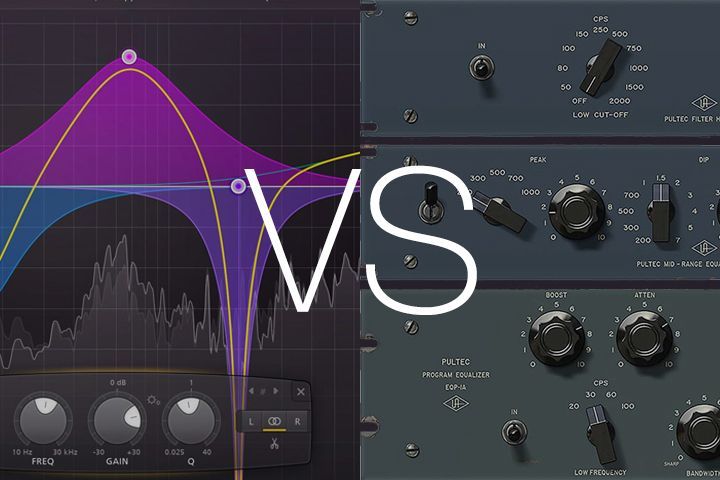This guide highlights the differences between digital and analog modeled EQ plugins. It also offers some general mixing tips.

One of the most fundamental processes deployed during a project is equalization. EQ’s are necessary tools every musician should have in their arsenal.
Using EQ’s to treat your music is essential for achieving clarity and depth, removing problematic frequencies, enhancing musical frequencies, balancing various elements in a mix, and shaping sounds in creative ways.

There are several types of equalizer plugins, each designed for various uses. The most common equalizers used are parametric, semi-parametric, graphic, and shelving equalizers. Equalizer plugins can also be categorized as either digital or analog emulations of classic hardware, all of which have their own characteristic sound and functionality.
With an overload of EQ types and options on the market, it can become difficult to know which type of EQ to use and why. This guide aims to highlight the differences between digital and analog modeled EQ plugins while also offering some general mixing tips.
Digital EQ’s
Digital EQ’s are excellent for corrective work because they are ultra-precise, highly configurable, and the most transparent sounding.
Parametric EQ’s are the most common and flexible form of digital equalization used in music production for any corrective work or creative filtering. This equalizer offers fully configurable and adjustable frequency bands. You can also enable or disable each band to individually cut, boost, and filter frequency ranges with the highest precision. Parametric equalizers excel at shaping tones and doing surgical work like cutting harsh, unpleasant or masking frequencies with pinpoint accuracy. This type of EQ is also very transparent and doesn’t color the sound like a modeled analog EQ does when cutting and boosting frequencies. In addition, parametric EQ’s are great for more creative processing like creating different filter effects, adding movement, or shaping a sound in unique ways.
Fabfilter’s Pro-Q 2 is an excellent example of a digital parametric equalizer used to sculpt sounds with high accuracy and transparency. This fully-featured EQ sports an impressive Retina interface that’ offers 24 EQ bands, top quality linear phase operation, zero latency, unique Natural Phase modes, Mid/Side processing, variable stereo placement of EQ bands, an intelligent solo feature, optional Auto Gain, and a built-in, fully customizable spectrum analyzer.
Analog Modeled EQ’s
Analog-modeled EQ’s are ideal for tonal work and sweetening. These types of EQ’s capture the warmth, character, and sound of vintage hardware equalizers. They excel at emphasizing or attenuating certain frequency bands in a broad, musical manner to achieve more clarity and punch. In addition, they are more affordable and reliable than expensive aging hardware.
With advancements in technology, plugin developers can identify the best attributes of sought-after classic hardware and accurately recreate software versions of their original analog counterparts. Many recreations also combine modern additions to meet today’s demands.
Analog-modeled EQ’s are considered to be very musical because of their ability to produce rich harmonics and simulate the desired imperfections of analog circuitry. Some EQ emulations like UAD’s Pultec EQ Collection will add desirable coloration without even turning a knob. Simply running sounds through its modeled circuitry will enhance your tracks with analog vibe.
Most classic equipment can be physically modeled in the digital world. Analog equipment that exhibits high‑bandwidth, nonlinear behavior presents the biggest challenges in creating accurate models. But it’s often the sound of these nonlinearities that makes the original analog equipment so desired. Put simply, the more nonlinear the behavior, the more complex the physical model will be, and the more processing power needed. Dave Berners, Chief Scientist at Universal Audio
EQ Mixing Tips
- Using multiple EQ’s in a single chain is ok.
- Digital EQ’s are better for making precision cuts and analog EQ’s are better for boosting. Excessive boosting of digital EQ’s can introduce unpleasant digital distortion. Excessive boosting on most analog modeled EQ’s can introduce pleasant saturation similar to what occurs when you overdrive the amplifiers on hardware versions.
- Use a Digital EQ first to remove unnecessary low frequencies and cut any problematic frequencies.
- Use an Analog modeled EQ towards the end of the effects chain to give your sounds some final polish and characterful enhancement.
- Analog modeled EQ’s each have their own unique sound, and the different styles will give you varying results so try a few out.
- Try automating the different frequency nodes on a parametric EQ to create various sound effects.
- Try cutting a frequency range with one type of EQ followed by another EQ that boosts those same frequencies to alter the resonant dip. This trick has a nice boosting and tightening effect that works well on bass and kick drums.

Turn your passion for music into a Profession: Learn more about our Music School Programs!
MORE ARTICLES FROM THE ICON BLOG

FIND YOUR SOUND, HONE YOUR CRAFT:
Are you ready to turn music into a career? ICON prepares students to become music producers, composers, performers, recording artists, professional DJs, and entrepreneurs in the entertainment industry. Click below to get information about our award-winning programs:

